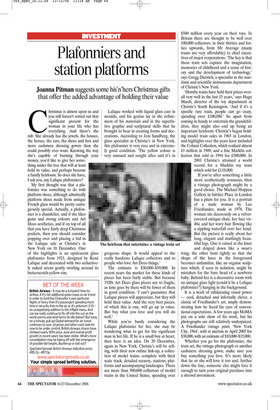Plafonniers and station platforms
Joanna Pitman suggests some his’n’hers Christmas gifts that offer the added advantage of holding their value Christmas is almost upon us and you still haven’t sorted out that significant present for the woman in your life who has everything. And there’s the rub. She already has the jewels, the houses, the horses, the cars, the shoes and furs and more cashmere dressing gowns than she could possibly ever want. Knowing the way she’s capable of burning through your money, you’d like to give her something under the tree that will at least hold its value, and perhaps become a family heirloom. So does she have, I ask you, any Lalique plafonniers?
My first thought was that a plafonnier was something to do with platform shoes, although admittedly platform shoes made from antique French glass would be pretty outrageously special. Actually, a plafonnier is a chandelier, and if she likes gems and strong colours and Art Deco aesthetics, and if on top of all that you have fairly deep Christmas pockets, then you should consider popping over and placing a bid in the Lalique sale at Christie’s in New York on 18 December. One of the highlights is an opalescent glass plafonnier from 1921, designed by René Lalique and decorated with two seductively naked sirens gently swirling around its butterscotch-yellow rim. Lalique worked with liquid glass cast in moulds, and his genius lay in the refinement of his materials and in the superlative graphic and sculptural skills that he brought to bear in creating forms and decorations. According to Jeni Sandberg, the glass specialist at Christie’s in New York, this plafonnier is very rare and in extremely good condition. ‘The yellow colour is very unusual and sought after and it’s in gorgeous shape. It would appeal to the really hardcore Lalique collectors and to people who love Art Deco things.’ The estimate is $30,000–$50,000. In recent years the market for these kinds of pieces has been fairly stable. But because 1920s Art Deco glass pieces are so fragile, as time goes by there will be fewer of them in good condition. ‘I can’t guarantee that Lalique pieces will appreciate, but they will hold their value. And the very best pieces, of which this is one, will go up in value. But buy what you love and you will do well.’ While you’re busily considering the Lalique plafonnier for her, she may be wondering what to get for the significant man in her life. If he is a small boy at heart, then here is an idea. On 20 December, again in New York, Christie’s will be selling, with their new online link-up, a collection of model trains, complete with their scale track, detailed scenery, stations, platforms and accompanying landscapes. There are more than 500,000 collectors of model trains in the United States, spending over $500 million every year on their toys. In Britain there are thought to be well over 100,000 collectors, in their thirties and forties upwards, from Mr Average (many trains are very affordable) to chief executives of major corporations. ‘The key is that these train sets capture the imagination, memories of childhood and a sense of history and the development of technology,’ says Gregg Dietrich, a specialist in the maritime and scientific instruments department of Christie’s New York.
‘Hornby trains have held their prices overall very well in the last 15 years,’ says Hugo Marsh, director of the toy department at Christie’s South Kensington. ‘And if it’s a specific rare train, people can go crazy, spending over £100,000.’ So apart from coming in handy to entertain the grandchildren, they might also end up being an important heirloom. Christie’s began holding model train sales in 1965 in London, and highlights over the years have included the Coluzzi Collection, which realised almost £1 million in 1989, and a fine Marklin collection that sold in 1994 for £500,000. In 2001 Christie’s attained a world record for a Marklin toy train which sold for £110,000.
If you’re after something a little more aesthetically sensuous, then a vintage photograph might be a good choice. The Michael Hoppen Gallery in Jubilee Place in London has a plum for you. It is a portrait of a nude woman by Lee Friedlander, made in 1978. The woman sits decorously on a velvetcovered antique chair, her face visible and her wavy hair flowing like a rippling waterfall over her hand. But the picture is really about her long, elegant and startlingly beautiful legs. One is raised at the knee and draped down like a swan’s wing; the other bent tightly so that the shape of the knee in the foreground becomes unfamiliar, like an organic sculpture which, if seen in isolation, might be mistaken for the bare head of a newborn baby. Behind her is a decorative room with an antique glass light (could it be a Lalique plafonnier?) hanging in the background.
It is a work of exhilarating visual power — cool, detached and infernally clever, a classic of Friedlander’s art, amply demonstrating how he freed his eyes of conventional expectations. A few years ago MoMA put on a solo show of his work, but his photographs are still relatively underpriced. A Friedlander vintage print, ‘New York City, 1964’, sold at auction in April 2005 for $38,000, with an estimate of $10,000–$15,000.
Whether you go for the plafonnier, the train set, the vintage photograph or another cashmere dressing gown, make sure you buy something you love. It’s more likely that he or she will love it too and, further down the line, someone else might love it enough to turn your original purchase into a shrewd investment.






































































































































 Previous page
Previous page